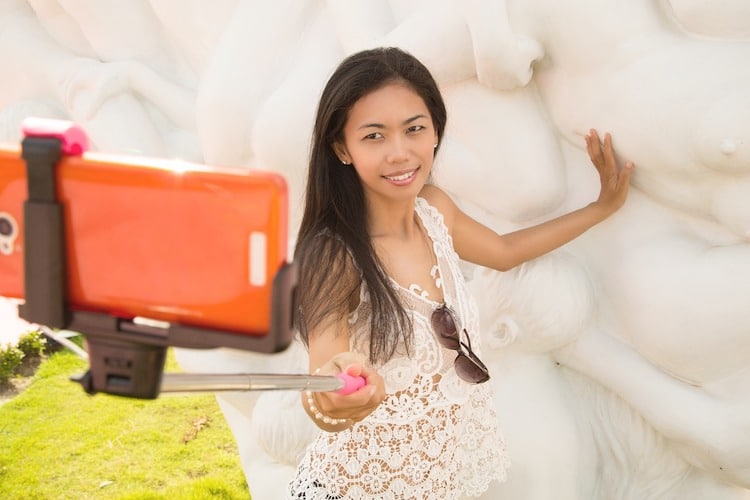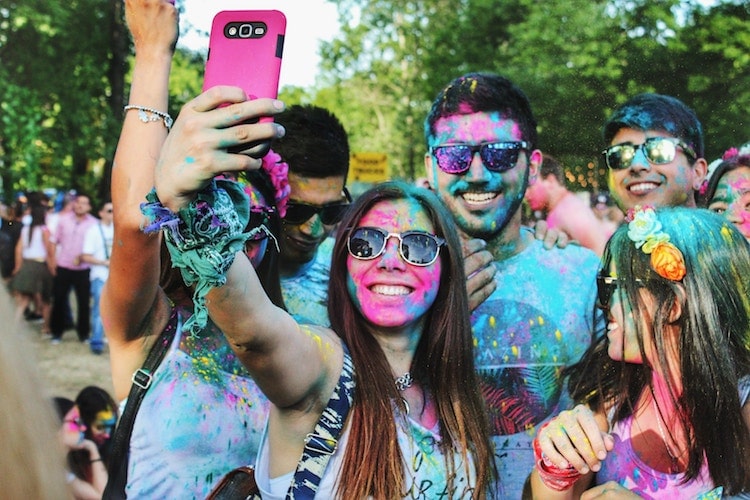
Photo: Nicole De Khors
When the word ‘selfie’ entered the Oxford English Dictionary in 2013, it was clear this photo trend was here to stay. Of course, people have been painting—and photographing—self-portraits for centuries, but the quick immediacy of a selfie has become ubiquitous with contemporary life. But when does a fun photo become an obsession? If you are constantly picking up your phone and clicking, watch out—you may just suffer from selfitis.
Defined as an “obsessive taking of selfies,” the concept of selfitis first made the rounds online in 2014, when international media said that it has been classed as a mental disorder by the American Psychiatric Association. This turned out to be a hoax, but sparked real research and now, in a newly published study in the International Journal of Mental Health and Addiction two researchers claim the condition is real.
Janarthanan Balakrishnan of the Thiagarajar School of Management in Madura, India, and Mark D. Griffiths of Nottingham Trent University in Nottingham, UK set about studying the behavior of over 600 Indian university students, using their behavior to break down selfitis into three levels—acute, chronic, and borderline. In doing so, they developed the Selfitis Behavior Scale (SBS), which is broken down into several subcategories indicative of why people take selfies. With an average age of 20, the students were the perfect age to explore the phenomenon.
Balakrishnan and Griffiths started with a pool of 225 students to create the scale, then verifying their findings with another group of 400 students. Environmental enhancement, social competition, attention seeking, mood modification, self-confidence, and social conformity were the six factors most indicative of why people were taking selfies and are used on the SBS to grade the level of selfitis in each test group. Of the six subcategories, high levels of social competition were one of the main indicators of those suffering from chronic selfitis. In fact, researchers noted that social competition is a big factor in other obsessive behaviors, such as excessive video gaming or gambling.

Photo: 1475341
After developing the scale, a test pool of 400 students came back with interesting results. It turned out that 34% suffered from borderline selfitis, 40.50% acute, and 25.50% had chronic selfitis. Males had a slightly higher rate of selfitis—57.50% compared to 42.50% for women. Unsurprisingly, the younger the test subject, the higher the rate of selfitis. A little over half of the participants aged 16 to 20 suffered from some degree of selfitis, with the numbers dropping sharply after 25 years of age.
“Typically, those with the condition suffer from a lack of self-confidence and are seeking to ‘fit in’ with those around them and may display symptoms similar to other potentially addictive behaviors,” Balakrishnan shared with the New York Post.
So how many selfies a day were the students taking? Not as many as you would think—55% took 1 to 4 selfies daily, with only 9% taking more than 8. And interestingly, 34% never even posted their selfies online.
And you? Where do you think you fall on the scale of behavior?

Photo: Julián Gentilezza
To understand how selfitis escalates, let’s look at the SBS scale and the increase in obsessive behavior under each subcategory.
Factor 1: Environmental enhancement
- 1.1 Taking selfies gives me a good feeling to better enjoy my environment
- 1.2 I am able to express myself more in my environment through selfies
- 1.3 Taking selfies provides better memories about the occasion and the experience
- 1.4 I take selfies as trophies for future memories
Factor 2: Social competition
- 2.1 Sharing my selfies creates healthy competition with my friends and colleagues
- 2.2 Taking different selfie poses helps increase my social status
- 2.3 I post frequent selfies to get more ‘likes’ and comments on social media
- 2.4 I use photo editing tools to enhance my selfie to look better than others
Factor 3: Attention seeking
- 3.1 I gain enormous attention by sharing my selfies on social media
- 3.2 I feel more popular when I post my selfies on social media
- 3.3 By posting selfies, I expect my friends to appraise me
Factor 4: Mood modification
- 4.1 I am able to reduce my stress level by taking selfies
- 4.2 Taking more selfies improves my mood and makes me feel happy
- 4.3 Taking selfies instantly modifies my mood
Factor 5: Self-confidence
- 5.1 I feel confident when I take a selfie
- 5.2 I become more positive about myself when I take selfies
- 5.3 I take more selfies and look at them privately to increase my confidence
Factor 6: Subjective conformity
- 6.1 I gain more acceptance among my peer group when I take selfie and share it on social media
- 6.2 I become a strong member of my peer group through posting selfies
- 6.3 When I don’t take selfies, I feel detached from my peer group.
How do you know if you suffer from selfitis? Answer each statement on a scale of 1 (strongly disagree) to 5 (strongly agree) and then add up your answers. The higher the number, the greater the chances you suffer from some form of selfitis.
h/t: [Peta Pixel]
Related Articles:
Photogenic Cat Masters the Art of Taking Purrfect Selfies
Real-Life Dr. Dolittle Explains How to Take Selfies with All Kinds of Wild Animals
Ingenious Smartphone Attachment Helps Dogs Smile for a Selfie with Their Humans
